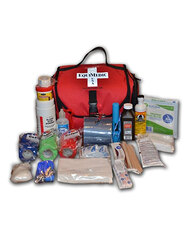Horse Cooling Guide: Preventing Overheating and Heat Stress After Exercise

How to Cool a Horse Safely After Exercise: Preventing Overheating and Heat Stress in Australian Summers
Updated September 2025
A complete Australian guide to recognising, preventing, and treating heat stress in horses - including proven cooling methods, hydration tips, and the best summer gear like fly mesh rugs and electrolytes to keep your horse safe, calm, and comfortable after work.
Riding in the Australian summer is tough on horses. They generate huge amounts of heat during exercise, and when temperatures soar, their natural cooling systems can fall behind. If not managed carefully, this can quickly lead to heat stress or even heatstroke. This guide explains how to prevent overheating, how to cool your horse safely after exercise, and what steps to take if your horse does get too hot. You will also see how the right gear, from fly mesh rugs to grooming brushes, makes summer horse care easier and more effective.
Why Horses Struggle in the Heat
Horses are natural athletes, but their size and muscle mass mean they produce a lot of heat. Sweating and evaporation are their main ways to stay cool, yet in hot, humid, or still conditions, sweat does not evaporate quickly enough. Dark coats, excess weight, or poor fitness can all make the problem worse. Knowing these risks is the first step in keeping your horse safe when the weather turns extreme.
Smart Prevention Before You Ride
The easiest way to stop heat stress is by planning ahead. Ride in the early morning or late evening when it is cooler, and swap out intense sessions for lighter work on the hottest days. Make sure water is always available before, during, and after exercise. What your horse wears also matters. Avoid heavy covers that trap heat and choose lightweight summer rugs or breathable fly rugs that protect from sun and insects without overheating.
Cooling Your Horse After Exercise
After riding, allow your horse to walk for 5–10 minutes to lower his heart rate naturally. Once untacked, hose with cool water starting at the legs, then move up to the chest, shoulders, and hindquarters. Always scrape away excess water in hot, still air to prevent it from insulating the body. Repeat hosing and scraping until your horse feels cooler. Move them to shade or a breezy stable and provide fresh, clean water. If they have sweated heavily, adding electrolytes helps replace lost salts and supports faster recovery.
Spotting the Warning Signs of Heat Stress
Even with prevention, horses can overheat. Watch for signs such as heavy sweating, rapid breathing, and a high heart rate. Horses may seem dull, stumble, or act distressed. A very serious warning sign is when sweating stops altogether. If your horse feels hot and dry or shows a delayed skin pinch response, dehydration is likely. A rectal temperature above 38°C means urgent action is needed.
What To Do If Your Horse Overheats
If you suspect heat stress, move your horse into shade immediately and begin cooling with water. Hose or sponge the neck, underside, and hindquarters, scrape, and repeat. Offer frequent small drinks of tepid water rather than one large gulp. If available, set up a fan at a safe distance to improve airflow. Monitor vital signs closely, and if your horse does not improve within 10 minutes, call your veterinarian right away. Heatstroke can be fatal if not treated quickly. For more prevention tips, see our guide on feeding and colic prevention, since hydration and gut health often go hand in hand with heat management.
Supporting Summer Recovery with the Right Gear
Alongside good management, the right products can make a big difference. Lightweight summer rugs and fly mesh rugs keep horses cooler while protecting them from insects. Fly masks reduce irritation, and quality grooming brushes help clear sweat and improve circulation. Pairing with fly sprays helps keep your horse calm, which also reduces heat build-up. You can also read our seasonal hay feeding guide for extra tips on balancing diet, hydration, and comfort in tough climates.
Final Word
Safe summer riding is about prevention, quick cooling, and spotting trouble early. Ride at cooler times, use proven cooling techniques, and keep an eye on vital signs. With the right care and the right gear from Delzani, you can help your horse stay comfortable, safe, and healthy throughout Australia’s hottest months.
Written by Jane Griffiths - An experienced Australian horse owner and product developer with over three decades immersed in equestrian life. Jane has spent years refining horse rugs, tack, and riding apparel to better suit Australian climates. She has enjoyed countless weekends at gymkhanas, show jumping events, and pony club competitions with her daughter, and still loves hitting the trails with friends whenever she can. Her lifelong passion for horses and hands-on understanding of equine comfort continue to shape her practical, rider-first approach to horse care and product design.
Related Equestrian Guides
Equine Nutrition & Supplements
Delzani's range of horse nutritional supplements is specially designed to support your horse's health and performance. Whether you're looking to enhance your horse's diet, provide joint support, or use calming supplements, we have you covered at Delzani
Essential Horse First Aid Supplies
Looking for reliable and effective horse first aid supplies? We offer a wide range of essential items to help keep your horse healthy and happy, including wound care, bandages, poultices, and more. Trust Delzani for all your horse first aid needs.
Fly Mesh Horse Rugs Australia | High Airflow & Insect Protection
Keep your horse cool, bite-free, and comfortable. Delzani Fly Mesh Horse Rugs maximise airflow and UV protection for Australian summer paddocks with coat-friendly meshes and secure, contoured fits for everyday turnout.
Flag Horse Rugs Australia | 100% Cotton Airflow & Summer Comfort
Built for Australian summers, Delzani Flag Horse Rugs keep your horse cool, protected, and comfortable through extreme heat. Made from lightweight cotton flag fabric, they deliver unmatched breathability and freedom of movement.
Keep Your Horse Cool: 10 Proven Tips this Summer To Beat the Heat
Hot Aussie summers test every rider. From hydration and electrolytes to fly protection and summer rugs, these 10 proven tips keep your horse cool, comfortable, and safe when the heat is on.
What Can Horses Eat? Safe Fruits and Vegetables for Horses
Safe fruits and vegetables horses can eat in Australia, with guidance on portion sizes, feeding frequency, and foods to avoid. Practical tips for keeping your horse healthy, balanced, and rewarded with treats in moderation.
Best Horse Grooming Brushes & Combs in Australia
An Australian guide to horse grooming brushes and combs, covering brush types, benefits, routines, seasonal care, and Delzani’s HAAS collection for healthy, shiny coats.
Best Horse Coats Start Here: Top Foods and Supplements that Work
A glossy horse coat comes from within. Explore the best foods and supplements for Australian horses, including linseed, sunflower seeds, biotin, and omega oils, to promote coat shine, skin health, and long-term condition.
What Are Chestnuts and Ergots on Horses? Understanding These Unique Growths
Discover what chestnuts and ergots are on horses, those small, calloused growths on their legs. Learn why they exist, how to care for them, and what they reveal about your horse’s evolution and grooming routine.















